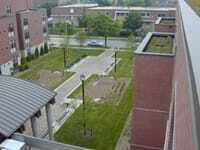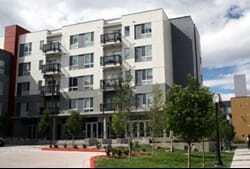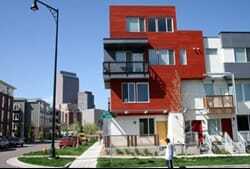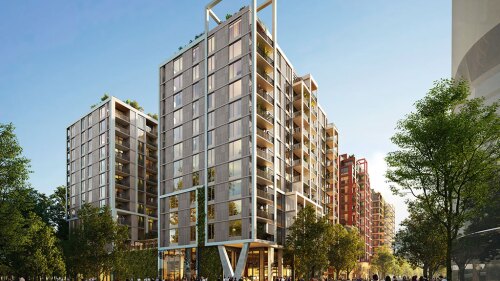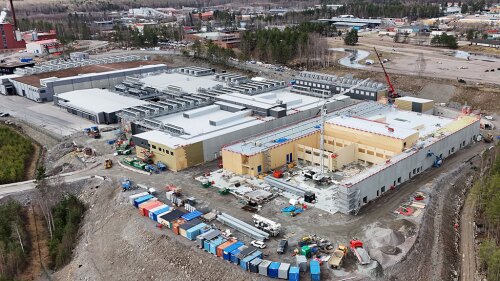In the current era of rising energy costs and shrinking budgets, the nation’s public housing agencies have a big incentive to lower utility bills. Some have done so by making significant investments in sustainable design strategies. Three housing authorities demonstrate strategies for “pushing the green envelope” and offer insights into what has worked best.
Nashville’s Metropolitan Development and Housing Agency (MDHA) began implementing energy and water conservation in the 1990s to cut utility bills. Last year, it became the largest generator of solar power in Tennessee when it topped three of its existing high-rise residential buildings with photovoltaic panels. The agency has also incorporated variant refrigerant volume (VRV) systems in the high rises, a method common in Europe and Asia but still relatively new in the United States. The VRV systems are expected to lower heating costs by up to 60 percent.
The MDHA installed geothermal heating and cooling—also more frequently found in Europe—at Parkway Terrace, a 125-unit apartment complex. “You have to know the technology and how it works, but we find geothermal to be a more durable system than most,” says Phil Ryan, director of the MDHA and a member of ULI. “There seems to be less wear and tear on the components, and it’s requiring little maintenance. Our residents at this particular site pay their own utilities, so they couldn’t be more pleased.”
For the Housing Authority of the City of Milwaukee, the initial move toward sustainable strategies began with concerns about stormwater management. “Milwaukee has a combined sewer system in a large majority of the older part of the city, so during a heavy downpour, we may have overflows into Lake Michigan,” says Warren Jones, managing director of development for the authority. “Our designers chose the green roof to help delay the initial inrush of water.”
The authority put its first green roof on Highland Gardens, 114 units of housing for seniors and people with disabilities, completed in 2004. It was the Midwest’s largest residential green roof at the time. In addition to absorbing stormwater runoff, the vegetated roof provides insulation and helps reduce the heat-island effect in summer. Since then, the authority has put in low-flow showerheads and aerators in all its facilities, and its newer buildings have low-flow dual-flush toilets, highly energy-efficient mechanical systems, and green roofs.
Finding the Money
Funds come from a mix of sources. To install photovoltaic panels on its high rises, the MDHA drew on the American Recovery and Reinvestment Act and HUD’s energy performance contracting financing technique, which uses the cost savings from reduced energy consumption to pay back the initial cost of installing energy conservation measures. The agency entered into an energy performance contract with Siemens Industry, Inc.
The Denver Housing Authority has used energy performance contracting in a partnership with Honeywell to upgrade existing public housing units, incorporating geothermal heating and cooling systems. In 2009, the authority completed renovating the historic AB Hirschfeld Towers, which involved drilling 80 geothermal cores for a closed-loop ground source system.
| Olga Village, Milwaukee |
The Denver authority leveraged $20 million in HUD HOPE VI funds to redevelop 15 acres (6 ha) at Benedict Park Place into 633 mixed-income rental and homeownership residential units, which incorporate a 100-kilowatt photovoltaic system. “What really made it work for us on top of the HUD funding was the solar tax credits for businesses,” says Ismael Guerrero, executive director of the Denver Housing Authority and a member of ULI. “That brought our payback period for the solar panels down from about 12 years to five.”
Last year, the Housing Authority of the City of Milwaukee opened Olga Village, 37 affordable apartments developed in partnership with the local social service agency United Community Center. It includes 30 geothermal wells and a green roof, and has been designed to accommodate solar power as well. Funding sources included low-income housing tax credits, equity investment, federal stimulus money, and contributions from HUD, the city of Milwaukee, the Metro Milwaukee Sewerage District, local utility WE Energies, and Wisconsin’s energy efficiency program, Focus on Energy.
| Denver’s Benedict Park Place |
Leveraging Less Expensive Solutions
Going green doesn’t only involve high-tech solutions such as photovoltaics. “One simple water-saving measure is just running tests on your water lines and fixing any leaks,” says Ryan. Other lower-cost strategies he recommends include installing tankless water heaters and putting in fluorescent bulbs.
“There is no better place to start than the building envelope,” says Guerrero. “This still accounts for the majority of building operation savings. Windows are probably the number-one thing, especially in an older building, and then insulation.” In addition, changing over to compact fluorescent lightbulbs, digital thermometers, and low-flow toilets has made a big difference, Guerrero says. “We are seeing almost twice the savings in consumption than we had projected,” he adds.
Lessons Learned
| Denver’s Benedict Park Place |
Dialog with maintenance staff is essential. “One of the biggest lessons that we’ve learned is that some technologies require more maintenance than others,” says Jones. “The maintenance and management staff has to build the skills to keep up with the newer technologies. Everybody has to know what they’re getting into. If they don’t, you either see early failures of systems or you don’t get the most out of them.”
For other housing agencies looking to increase their use of sustainable design strategies, Ryan says, “Be bold. Don’t think you can’t use a technology without giving it a thorough look. Housing authorities and other big institutional users, we typically have much longer periods of ownership, so we ought to be the ones leading the way in technologies. If not us, who will?”


